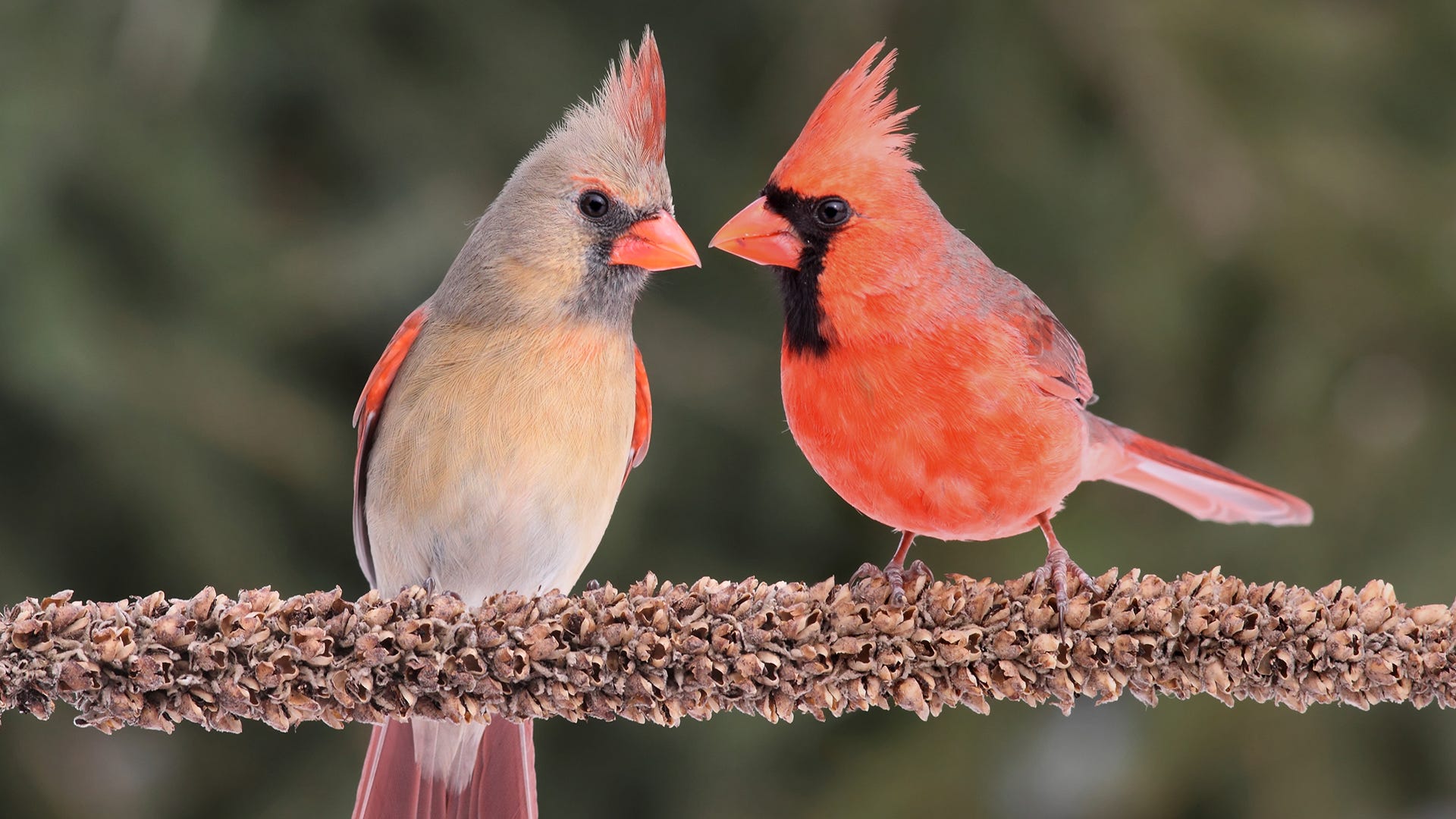Northern Cardinals are some of the most striking songbirds in all of North America. These cheery mid-sized birds have many unique traits, one of which is their bright coloring that differs by sex. In this article we will look at male vs female cardinals and find out what other differences they may have from each other.
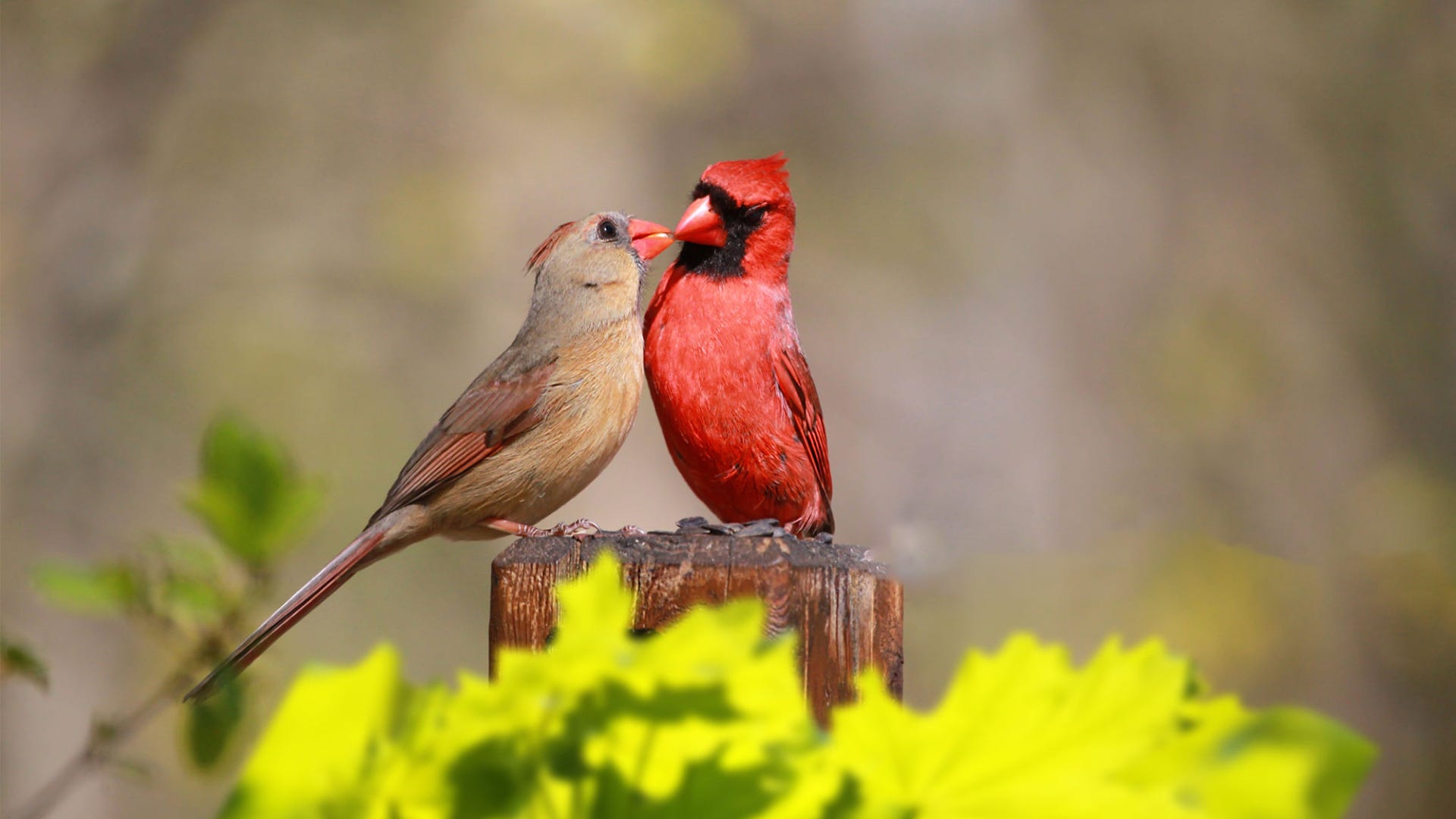
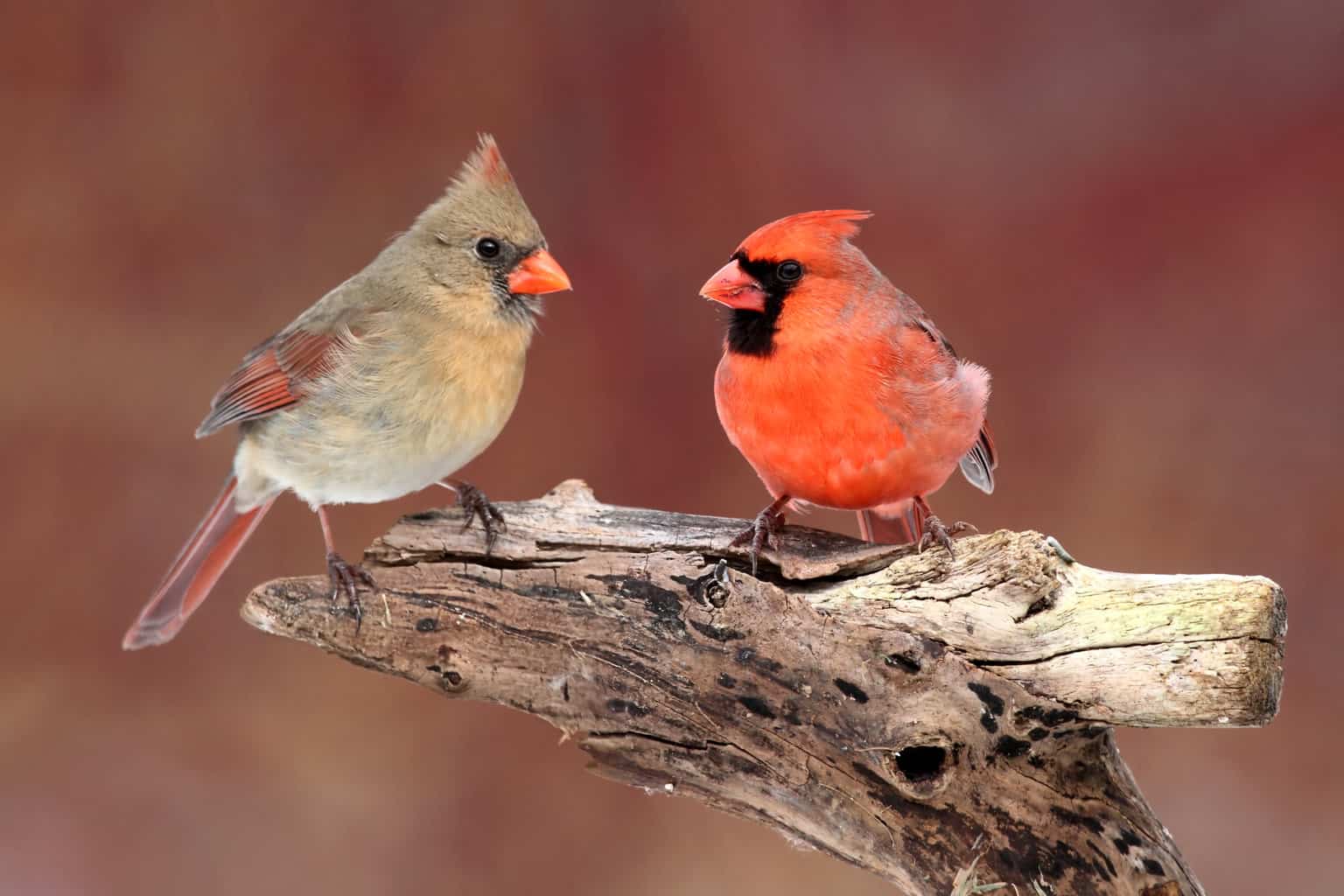
5 DIFFERENCES BETWEEN MALE VS FEMALE CARDINALS
From behavior to song, male and female Cardinals have many different traits that make them unique.
This article discusses the general behaviors and appearances of the male and female cardinal. We also identify five fun facts about the differences between the sexes.
First, let’s look at what are the main characteristics are of each sex, and how that affects the way they act.
1. MALES ARE BRIGHT RED
Only males are bright red. From their head to the tip of their tail, these songbirds have scarlet feathers. The only exception is a dark black chin patch and mask around the beak and eyes.
Females have a little red on them, but they have evolved to blend into environments, not stand out.

2. MALES SING LOUDER AND CHIRP MORE FREQUENTLY
The male Cardinal’s song is particularly loud and insistent in the spring, when squabbles over territory are common and every male must be vigilant for intruders that might steal a female away from him.
To let his competition know that he’s there – and to clue females in on his availability – the male Cardinal chirps loudly.
3. FEMALES’ CRESTS ARE SMALLER THAN MALES’
Cardinals are sexually dimorphic, meaning that males and females look different, even though they are the same species. Females have a silhouette similar to males; but their crest is smaller, their feathers are more subdued, and they may be slightly smaller in size.
 Male Northern Cardinals can get along and spend time together outside of the breeding season.
Male Northern Cardinals can get along and spend time together outside of the breeding season.4. MALE CARDINALS ARE MORE TERRITORIAL THAN FEMALES
While both males and females are known to defend their territory and nests from competitors and predators, males are by far the most territorial. In the spring, males stake out a territory and sing to alert other males that it’s a no-fly zone.
Females also rely on males to protect them when they are incubating a nest.
5. FEMALES ARE THE ONLY NEST-BUILDERS.
Males trail after their mate when she selects a nest site in his territory. He leaves the task of building the nest building up to her, since she is the one that incubates the eggs. However, he brings his mate sticks, which she incorporates into the grand design. He may even stop by just to observe while she is building.
MALE CARDINALS
 Image: Male Northern Cardinal | Jean Beaufort | publicdomainpictures.net
Image: Male Northern Cardinal | Jean Beaufort | publicdomainpictures.netPLUMAGE
The male Cardinal’s vibrant red plumage is one reason why this songbird is one of the most colorful and well-known and birds in the United States.
The pigment that colors a male’s feathers bright red is rhodoxanthin, a type of carotenoid that can be found in bright red berries that Cardinals love to eat. In fact, the degree of brightness in a male Cardinal’s red feathers is likely due to how many of these berries he consumes.
Males also sport a black eye mask and throat, and reddish-orange beak.
BEHAVIOR
Male Cardinals are notorious for being territorial during breeding season. They will not tolerate other males entering their area. They will chase off or even fight other males.
Sometimes they mistake their own reflection in windows for an intruding male. This can lead to them pecking and flapping at windows, and unfortunately sometimes flying right at their reflection resulting in injury.
Outside of breeding season, males are content to sit on visible perches and be conspicuous. They are not shy and they prefer to dominate environments with their song. They are also able to hang out in social groups with other males and not be aggressive.
SONG
The male Cardinal’s characteristic sharp “chip” is well-known throughout much of North America. They can also sing several songs that have a whistle-like quality. They sing loudly from perches to protect their territory.
 photo credit: John Wisniewski (Male cardinal feeding female during mating ritual)
photo credit: John Wisniewski (Male cardinal feeding female during mating ritual)DIET
Both male and female Cardinals generally eat the same thing: an omnivorous mixture of seeds, insects, and berries. They will visit your yard readily if you offer mixed seed or their favorite, black sunflower.
COURTSHIP BEHAVIORS
You already know that male Cardinals are territorial, but did you know that they have a romantic side too? After they scare other males off, a male will woo his intended mate by singing softly, lifting his head, and swaying. When she joins in, he knows it’s a match.
At the beginning of the relationship, males bring seeds to their mates and feed them as part of a bonding process. Some say the way the birds feed each other – beak to beak – looks a lot like kissing. During nesting, the male will bring food to the female while she performs incubation duties. He will also defend the nest.
FEMALE CARDINALS
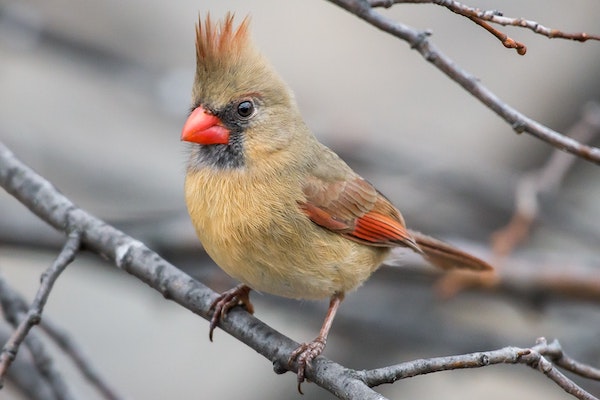 Female Northern Cardinal
Female Northern CardinalPLUMAGE
Unlike the bright red male, female Cardinals are a tawny brown with muted red accents on their wings, crest, and tail. They have the same reddish-orange beak as males, however the black mask on their face is much lighter.
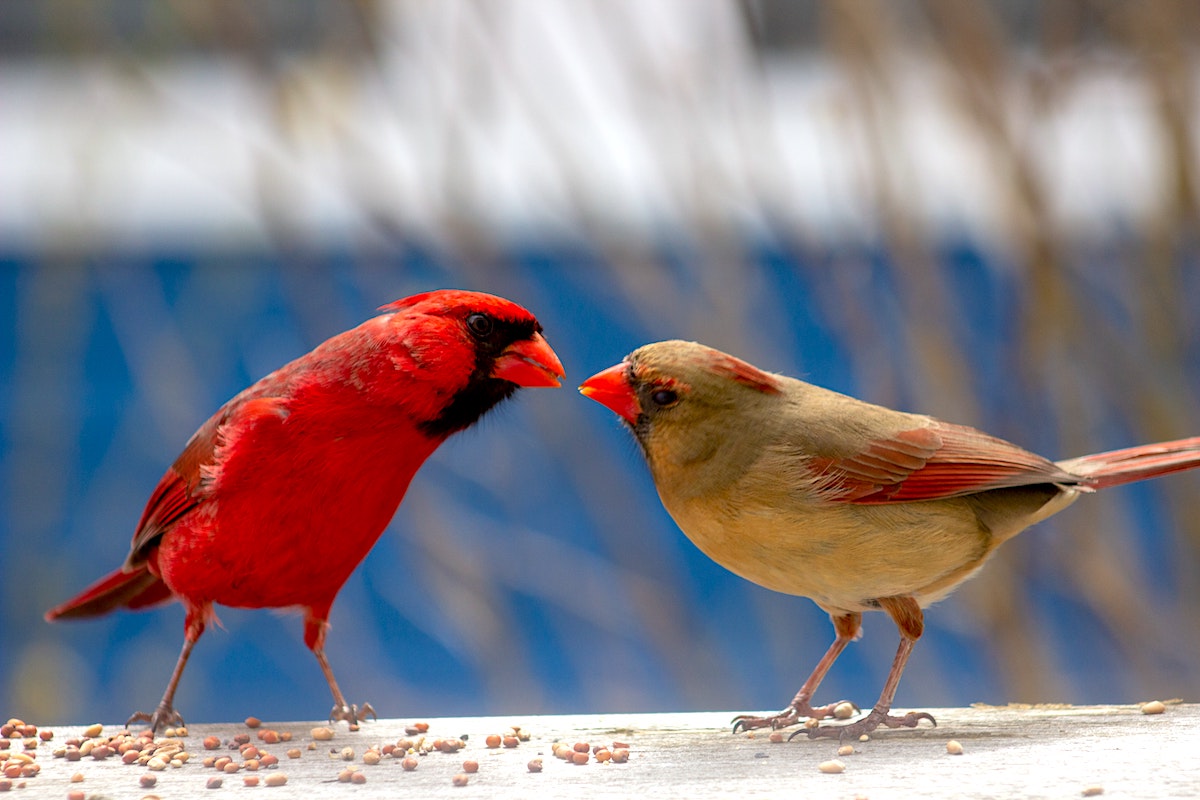
BEHAVIOR
Female Cardinals are more timid than males. Their subtle orange-rust coloring allows them to blend in with foliage and thickets, which helps when nesting. Sometimes, all that can be heard of the female Cardinal is her chirp.
You may see females attacking windows during the peak of breeding season like the males, however males are much more likely to do this.
SONG
Cardinals are one of the only North American songbird species where the female sings! The female Cardinal’s song often clues her mate into her location so he can bring back food to feed chicks. Females may not sing as aggressively, but their songs can be even more complicated and longer in length than the male’s.
DIET
Both male and female Cardinals generally eat the same thing: an omnivorous mixture of seeds, insects, and berries.
 Male cardinal feeding the female while she sits on the nest | Image by Michaela Wenzler from Pixabay
Male cardinal feeding the female while she sits on the nest | Image by Michaela Wenzler from PixabayCOURTSHIP BEHAVIORS
Female Cardinals are wooed by a male, who impresses her with his bright red plumage and his song. They sing duets together and he feeds her seeds from his beak.
Once their relationship is established, the female and male go ‘house hunting.’ The female leads the male to different locations within his territory. She will choose a nesting site and will be the nest-builder. Females gather their own materials and may also be brought nest materials by the male. She will incubate the eggs.
CONCLUSION
Cardinals might be common, but they are certainly fascinating! The next time you see a male or female Cardinal in your backyard, consider doing some sleuthing to see if they are a pair. If its springtime, you may even have a chance to look in on a courtship dance.
